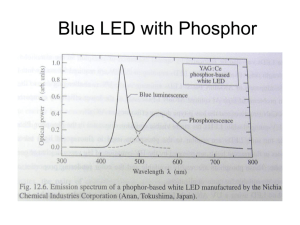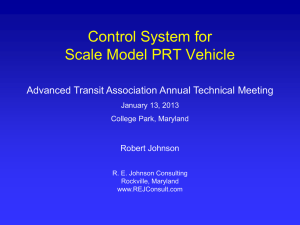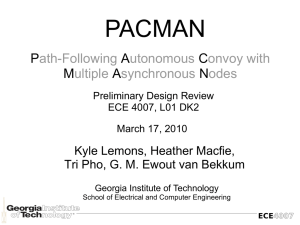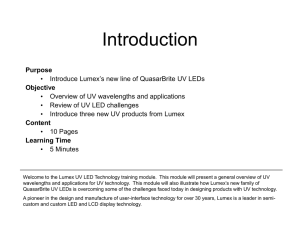smart street light system for power saving using pic
advertisement
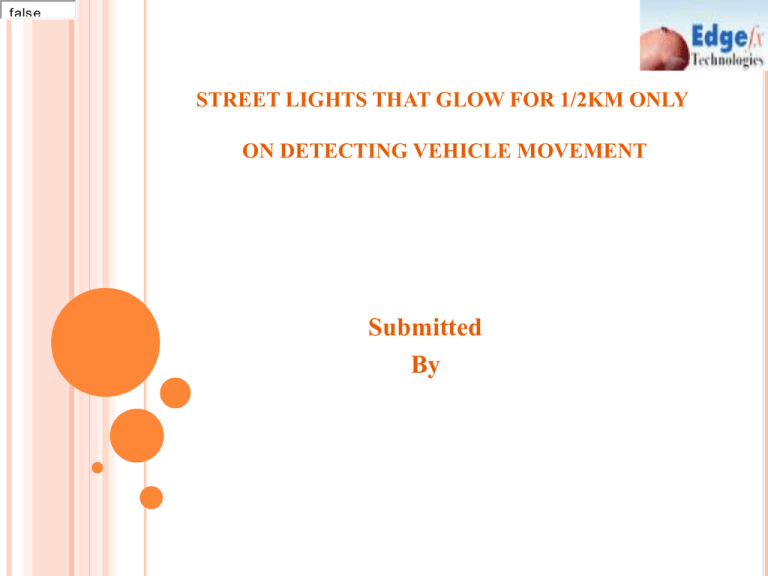
fals e STREET LIGHTS THAT GLOW FOR 1/2KM ONLY ON DETECTING VEHICLE MOVEMENT Submitted By fals e ABSTRACT IR Sensors used on either sides of the road send logic commands for the LEDs at the output to get glowing for a patch ahead. Intensity control is also possible by pulse width modulation based on sensing the movement and density of vehicles. Thus this way of dynamically changing intensity or off to on helps in saving a lot of energy. A programmable microcontroller is engaged to provide different duty cycle for different intensities at different density conditions. PREVIOUS TECHNOLOGY High intensity discharge lamp (HID) presently used for urban street light are based on principle of gas discharge, thus the intensity is not controllable by any voltage reduction method as the discharge path is broken. PRESENT DAY TECHNOLOGY White Light Emitting Diode (LED) based lamps are soon replacing the HID lamps in street light. As these LEDs can switch faster than HID lamps we can apply PWM concept to these LEDs. LEDs consume less power compared to HID lamps. Life time of LEDs is also more. BLOCK DIAGRAM HARDWARE REQUIREMENTS TRANSFORMER (230 – 12 V AC) VOLTAGE REGULATOR (LM 7805) RECTIFIER FILTER PIC MICROCONTROLLER (PIC16F877A) LEDS PHOTODIODES POTENTIAL DIVIDER BC547 1N4007 RESISTORS CAPACITORS POWER SUPPLY 230 V AC 50 Hz 12V step down transformer Bridge rectifier Filter(470µf) 5v Regulator 5V DC DESCRIPTION OF POWER SUPPLY The circuit uses standard power supply comprising of a step-down transformer from 230v to 12v and 4 diodes forming a Bridge Rectifier that delivers pulsating dc which is then filtered by an electrolytic capacitor of about 470microf to 100microF. The filtered dc being un regulated IC LM7805 is used to get 5v constant at its pin no 3 irrespective of input dc varying from 9v to 14v. The regulated 5volts dc is further filtered by a small electrolytic capacitor of 10 micro f for any noise so generated by the circuit. One LED is connected of this 5v point in series with a resistor of 330ohms to the ground i.e. negative voltage to indicate 5v power supply availability. fals e PIC MICROCONTROLLER(PIC16F877A) High-Performance RISC CPU: • Only 35 single-word instructions. • All single-cycle instructions except for program branches, which are two cycle. • Operating speed: DC – 20 MHz clock input DC – 200 ns instruction cycle • Up to 8K x 14 words of Flash Program Memory, Up to 368 x 8 bytes of Data Memory (RAM), Up to 256 x 8 bytes of EEPROM Data Memory. • Pin out compatible to other 28-pin or 40/44-pin, PIC16CXXX and PIC16FXXX microcontrollers. Special Microcontroller Features: 100,000 erase/write cycle Enhanced Flash program memory typical. • 1,000,000 erase/write cycle Data EEPROM memory typical. • Data EEPROM Retention > 40 years. • Self-reprogrammable under software control. • In-Circuit Serial Programming™ (ICSP™) via two pins. • Single-supply 5V In-Circuit Serial Programming. •Watchdog Timer (WDT) with its own on-chip RC oscillator for reliable operation. • Programmable code protection. • Power saving Sleep mode. • Selectable oscillator options. • In-Circuit Debug (ICD) via two pins. • Peripheral Features: Timer0: 8-bit timer/counter with 8-bit prescaler. • Timer1: 16-bit timer/counter with prescaler, can be incremented during Sleep via external crystal/clock. • Timer2: 8-bit timer/counter with 8-bit period register, prescaler and postscaler. • Two Capture, Compare, PWM modules - Capture is 16-bit, max. resolution is 12.5 ns - Compare is 16-bit, max. resolution is 200 ns - PWM max resolution is 10-bit • Synchronous Serial Port (SSP) with SPI™ (Master mode) and I2C™ (Master/Slave). • Universal Synchronous Asynchronous Receiver Transmitter (USART/SCI) with 9-bit address detection. • Parallel Slave Port (PSP) – 8 bits wide with external RD, WR and CS controls (40/44-pin only). • Brown-out detection circuitry for Brown-out Reset (BOR). • PIN DIAGRAM OF PIC16F877 PWM(PULSE WIDTH MODULATION) The term duty cycle describes the proportion of on time to the regular interval or period of time; a low duty cycle corresponds to low power, because the power is off for most of the time. Duty cycle is expressed in percent, 100% being fully on. The main advantage of PWM is that power loss in the switching devices is very low. When a switch is off there is practically no current, and when it is on, there is almost no voltage drop across the switch. PWM works also well with digital controls, which, because of their on/off nature, can easily set the needed duty cycle. The longer the switch is on compared to the off periods, the higher the power supplied to the load is. PHOTO DIODE A photodiode is a type of photo detector capable of converting light into either current or voltage, depending upon the mode of operation. Photodiodes are similar to regular semiconductor diodes except that they may be either exposed (to detect vacuum UV or X-rays) or packaged with a window or optical fibre connection to allow light to reach the sensitive part of the device. IR LED An IR LED, also known as IR transmitter, is a special purpose LED that transmits infrared rays in the range of 760 nm wavelength. Such LEDs are usually made of gallium arsenide or aluminum gallium arsenide. They, along with IR receivers, are commonly used as sensors. The appearance is same as a common LED. Since the human eye cannot see the infrared radiations, it is not possible for a person to identify whether the IR LED is working or not, unlike a common LED. To overcome this problem, the camera on a cell phone can be used. The camera can show us the IR rays being emanated from the IR LED in a circuit. PWM(PULSE WIDTH MODULATION) OPERATION OF PROJECT There are two basic modes of operation, 1. Transition of streetlights from dark to bright state. 2. Transition of streetlights from dim to bright state. In the first mode of operation, when the vehicle is not present, all the streetlights will be in dark state. When a vehicle is sensed then the window of streetlights is illuminated in front of the vehicle. SECOND MODE OF OPERATION In the second mode of operation, initially when the vehicle is not sensed, all the streetlights will be in dim state. This is achieved by use of pulse width modulation technique through the program stored in the microcontroller. When a vehicle is not present on the highway, then the streetlights are made to glow for about 1ms and then for 100ms they are switched off. Thus, we get streetlights with less brightness. When a vehicle is sensed, all the streetlights are illuminated for 1ms and the window of streetlights are illuminated for 100ms. Thus we have a PWM wave of 99% duty cycle. APPLICATIONS Highways Industries Museums ADVANTAGES Power saving LEDs consume less power Easily implementable Low cost

